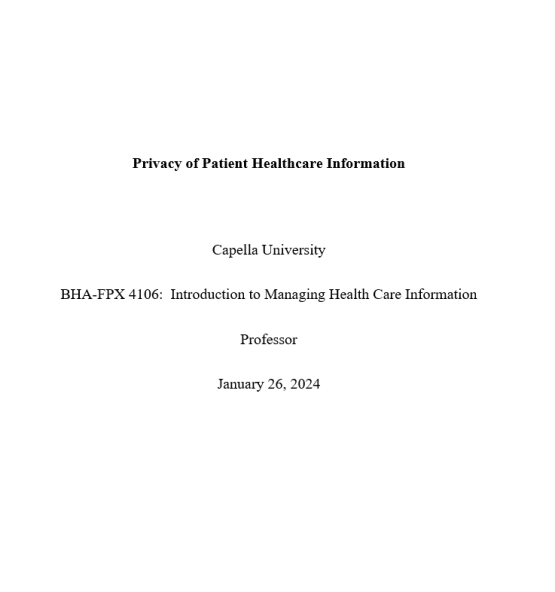


Privacy of Patient Healthcare Information
Capella University
BHA-FPX 4106: Introduction to Managing Health Care Information
Professor
January 26, 2024
Availability:In Stock
To ensure the documentation meets interoperability standards, it is crucial to ensure that systems exchange information efficiently and securely. One consideration for meeting interoperability standards is ensuring that information exchanged is accessible by only authorized users (Sorbie, 2020). Similarly, meting interoperability standards will require automation of patient admission, discharge details, and other relevant details
Integrating office information with an HIE has advantages and disadvantages. Health information exchange facilitates the sharing of patient-level health information between doctors, nurses, pharmacists, other health care providers. Integrating information with an HIE enhances efficiencies in the delivery of health care due to the speed and safety of information flow. Another advantage is that HIE prevents costly redundant tests ordered because one provider does not have access to the clinical information stored at another provider’s location. Further, integrating the office information with an HIE enhances compliance with provisions of the Health Information Technology for Economic and Clinical Health Act (HITECH). The care team understand obligations towards securing protected health information. The group understands consequences of violations, which encourages everyone to uphold values, behaviors, and attitudes for sustaining desired culture.
Disadvantages include uncertainty and reluctance by members of the care team to accept HIE or the integration. The lack of clarity for differences in rules across HIEs could lead to privacy and compliance issues with adverse implications on the organization. Strict EHRs standards are vital to overcome the risk of data security infringement (Rumisha et al., 2020). Challenges regarding the standardization of health information include the risk of insufficient implementation of existing or required standards. The situation trigger inefficient use of healthcare resources and difficulties adjusting to events in a complex and ever changing health care system.
Destroying information is also vital to enhance quality and safety of patient health information. PHI that is paper or physical should be shredded, burned, pulped, or pulverized that the refuse is indecipherable and cannot be put back together. According to Oachs and Watters (2020), overwriting PHI or degaussing help prevent the risk of unauthorized access to sensitive data.
Legal Considerations and a Plan for Compliance
Confidentiality and security measures remind healthcare professionals about the duty to take responsible steps to keep patient details confidential. Keeping information out of reach is a priority that makes everyone extra vigilant when handling sensitive information (Tariq & Hackert, 2020). Similarly, members of the care team should identify parties with authorization and permission to access to discuss protected health information (Sorbie, 2020). Further, training and education make everyone responsive to calls for confidential information. HIPAA security rule includes administrative, technical, and physical safeguards to ensure data integrity and confidentiality. Security measures include risks assessment, workforce training, and access controls appropriate for ensuring data integrity.
Any patient information that could be used to personally identify a patient divulges PHI and should thus be protected. Some information might not be part of PHI, such as test results that do not divulge any information about the patient. This result might be printed out on a piece of paper with no other identifying information with private information orally communicated to the doctor, or the only information available being the pseudonym of the patient. Any PHI used in the medical environment should be destroyed as soon as it is done being used. PHI entered into an EHI should be filed under a pseudonym and be subject to all security rules.
Reviews
There are no reviews yet.